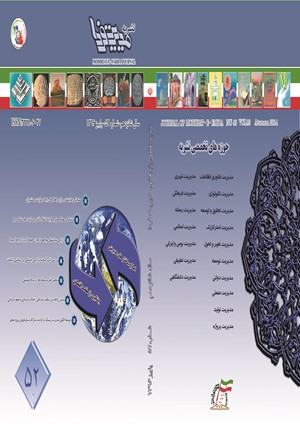هویت برند ملی صادراتی ایران و استراتژی ترفیع آن
محورهای موضوعی : مدیریت استراتژیکداود فیض 1 , سید محمد میرمحمدی 2 , محمد مهدی ایزدخواه 3
1 - دانشگاهسمنان
2 - دانشگاه تهران
3 -
کلید واژه: برند ملی صادرات ترفیع نظریه مبنایی مدلسازی ساختاری تفسیری,
چکیده مقاله :
برند مجموعه ای از ادراکات ذهنی نسبت به چیزی است که در طول زمان شکل می گیرد. یکی از قلمروهای برند، حیطه کشورها و ملت هاست بطوریکه تاکنون بیش از 50 کشور فعالیت هایی را بر روی برندشان متمرکز کرده اند تا جایگاه مطلوب برند ملی شان را در اذهان ایجاد کنند. برند ملی در دیدگاه آنهلت، شش بعد دارد: صادرات، گردشگری، جذب سرمایه گذاری و نخبگان، فرهنگ و میراث فرهنگی، مردم و حاکمیت. این پژوهش بر آن است که ابتدا جایگاه مطلوب برند ملی ایران در حوزه صادرات را استخراج کرده و پس از آن راهکارهای ترفیعِ برند مطلوب به ذهن مشتریان هدف را پیشنهاد دهد. در این مسیر ابتدا با استفاده از نظریه مبنایی، برند مطلوب، راهکارهای ترفیع برند و راهکار های توسعه صادرات استخراج گردیده و سپس با بکارگیری روش ساختاری تفسیری، مسیر اجرایی برندسازی ترسیم گردیده است. در نهایت، «بهتر از آن چه فکر می کنید» به عنوان جوهره برند ملی صادراتی و جایگاه مطلوب برند و همچنین، 10 راهکار به عنوان راهکارهای ترفیع برند صادراتی کشور تعیین شدند.
Brnading is the process involved in creating a unique name and image for a product in the people's mind, mainly through advertising campaigns and other methods with a consistent theme. Today, branding is drawn from a range of products to area sites and places such as cities and countries. A kind of branding that is about countries has been called nation branding. Nation branding aims to measure, build and manage the reputation of countries. Anholt believes that nation branding has six aspects: Export, Tourism, Investment and Immigration, Culture and Heritage, People and Governance. This paper will focus on aspet of export and wants to developing an export nation brand identity model for Iran. In order to extract the concepts of this model the grounded theory has been used. Then, to drawing the model, ISM has been used.
Cateora, P. R. and John L Graham, (2013), International Marketing (10th edition). Boston: Irwin/McGraw-Hill Publishing, P 220#
Martin, D. (2007) Rebuilding Brand America, Amacom, USA#
Kotler, P., Jatusripitak, S. and Maesincee, S., (1997), The Marketing of Nations, The Free Press, New York#
Kapfere J N, (2008), The new strategic brand management, Kogan Page, USA#
کاپفرر ژان نوئل، (1392)، مدیریت استراتژیک برند، ترجمۀ رستمی علی و عباسزاده معبود، جلد اول، نشر نورا، تهران#
Martin , I. M. and S. Eroglu (1993), "Measuring a Multi-Dimensional Construct: Country Image", Journal of Business Research, 28, 191-210#.
Kim, Y. (2006), “Do South Korean companies need to obscure theircountry-of-origin image? A case of Samsung”, corporatecommunications: An International Journal, Vol. 11, No. 2, pp: 126-137#.
Akhter, Syed.H. (2007)."Globalization, Expectations Model of Economic Nationalism, and Consumer Behavior". Journal of Consumer Marketing. 24(3) pp.142 –150#
Dichter,E. (1962).The world customer. Harvard Business Review, 40 (4), 113-122#
Schooler, R. D. (1965). "Product bias in the Central American common market." Journal of Marketing Research 2(November)#
Shocker, A.D., Srivastava, R.K. and Ruekert, R.W. (1994), “Challenges and opportunities facing brand management: an introduction to the special issue”, Journal of Marketing Research, Vol. 31 No. 2, pp. 149-158#
شجاعی سامره، (1389)، بررسی مدل اندازه گیری ارزش ویژه برند کشور مقایسه ارزش ویژه ژاپن و کره در لوازم صوتی و تصویری، راهنما: ابراهیمی عبدالحمید، دانشگاه آزاد#
Bilkey, W.J. and Nes, E. (1982), “Country-of-origin Effects on Product Evaluations”, Journal of International Business Studies, Spring/Summer, pp 89-99#
Pappu. Ravi,. Quester. Pascale G, Cooksey. Ray W, (2005), Consumer-based brand equity and country-of-origin relationship#
Keller, K. (2008). Strategic Brand Management. Pearson Prentice Hall: USA#
Keller, K. L. (1993). Conceptualizing, Measuring, and Managing Customer-Based Brand Equity. Journal of Marketing, 57(1), 1-22. http://dx.doi.org/10.2307/1252054#
Aaker , D. (2010), Improve Your Brand I.D . Marketing News , Vol. 44, no.4 , and p . 12#
Aaker, D. A. (1991). Managing Brand Equity. New York, NY: the Free Press#
Piron F. (2002). “International Outshopping and Ethnocentrism”. European Journal of Marketing, 36, 189-210#.
Kotler, P., Haider, D. H., Rein, I., (1993), "Marketing Places", THE FREE PRESS, New York#
Fan, Y. (2006). “The globalisation of Chinese brands”, Marketing Intelligence &Planning, 24:4, 365-379#
Dinnie Keith, (2008), Nation Branding , Concept, issues, practices, Elsevier Ltd, UK#
Rawson, G. (2007), “Perceptions of the United States of America: exploring the political brand of a nation”,Place Brandingand Public Diplomacy,Vol.3No.3,pp. 213-221#.
Jaffe, E.D. and Nebenzahl, I.D. (2001), National Image & Competitive Advantage. The Theory and Practice of Country-of-Origin Effect, Copenhagen Business School Press, Frederiksberg#
Pappu R., Quester G.P, Cooksey W.R., (2007), “Country image and consumer based brand equity: relationship and imlications for international marketing”, Journal of International Business Studies, 3.pp. 726-745#.
معصوم زاده زواره ابوالفضل، (1390)، شمسی جعفر، برندسازی ملی، شرکت چاپ و نشر بازرگانی، تهران#
ایزدخواه محمد مهدی، (1395)، بازارسازی فرهنگی، انتشارات مرکز مطالعات و برنامه ریزی شهر تهران، تهران#
زارعی عظیم، ایزدخواه محمدمهدی(1394)، الگوسازی ساختاری تفسیری نقشه استراتژی در شرکت مادرتخصصی، پژوهشهای مدیریت در ایران، دوره19، شماره3، صص141-166#
Anukul Mandal, S.G. Deshmuk, (1994), “Vendor Selection Using Interpretive Structural Modelling (ISM)”, Inernational Journal of Operation &Production Management, Vol. 14, No.6 .pp52 – 59#
Bagherinejad Zahra, Kazemzadeh Baradaran Reza, Asadi Roohangiz, (2013), Identifying and Ranking of the Success Factors inAutomotive Reverse Logistics throughInterpretive Structural Modeling (ISM), Management Researches in Iran, Vol.17, No.1 .pp 21 - 40#
Azar Adel, Tizro Ali, Moghabel Abas, Rostami Anvari Ali,(2008) “Modeling the Agility of Supply Chain Using Interpretive Structural Modeling Approach”, Management Studies in Iran, Volume 14, Issue 4 .pp 1-25#
Bolanos Ricardo, Emilio Fontela, Alfredo Nenclares, Pablo Pastor, (2005), “Using interpretive structural modeling in strategic decision-making group”, Management Decision, Vol. 43 Issue,6 .pp 877 -89


